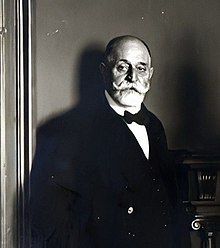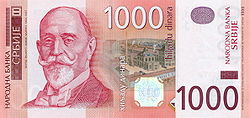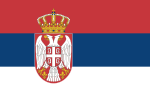| Đorđe Vajfert Ђорђе Вајферт | |
|---|---|
 | |
| 3rd Governor of the National Bank of Serbia | |
| In office 1890–1902 | |
| Preceded by | Filip Hristić |
| Succeeded by | Tihomilj J. Marković |
| 5th Governor of the National Bank of Serbia (Yugoslavia) | |
| In office 1912–1926 | |
| Preceded by | Tihomilj J. Marković |
| Succeeded by | Ljubomir Srećković |
| Personal details | |
| Born | 15 June 1850 Pančevo, Austrian Empire |
| Died | 12 January 1937 (aged 86) Belgrade, Kingdom of Yugoslavia |
| Nationality | Serbian |
| Signature | |
Đorđe Vajfert (Serbian Cyrillic: Ђорђе Вајферт, German: Georg Weifert; 15 July 1850 – 12 January 1937) was a Serbian industrialist, Governor of the National Bank of Serbia and after 1920 the National Bank of Yugoslavia. In addition, he is considered the founder of the modern mining sector in Serbia and a great benefactor.
Biography
Georg Weifert was born in Pančevo, German Banat to a Danube Swabian family. From an early age Đorđe Vajfert worked with his father, Ignatz Weifert in Belgrade, in brewing. Theirs was the first brewery in the Kingdom of Serbia. He graduated from the Braumeisterschule in Weihenstephan, near Munich. Then he returned to Serbia and took over the brewery of his father, which he expanded. With the profits he bought a coal mine in Kostolac, then a copper mine in Bor, a Steinberg works at Zaječar and finally a gold mine. With the proceeds from the mines, he was the richest man in Serbia and was considered the greatest industrialist of the future Yugoslavia.
In 1890 Vajfert was appointed Governor of the National Bank of Serbia. He served in this capacity from 1890 to 1902, and again from 1912 to 1914/1918. During this period he acquired a good reputation maintaining the value of the Serbian dinar and in credit. After 1918, because of his good offices, Vajfert was appointed Governor of the National Bank of Yugoslavia. His best-known arrangement as Governor was the conversion of the Austro-Hungarian krone into the new Yugoslav dinar. This also led to great criticism, as the former Serbian dinar was exchanged 1:1 in the new dinar, the Austrian money into a 4:1 ratio – this led to substantial losses of property of those Yugoslavs who formerly lived in Austria-Hungary.

Đorđe Vajfert was an important patron and supporter of humanitarian and cultural institutions. He donated his prized collection of ancient coins and his private library to the University of Belgrade. In Pančevo, from where his parents Ignatz and Anna originated, he left the Roman Catholic Church a small chapel known as Anina crkva (Anna's church), in memory of his mother.
Vajfert was a major benefactor in the opening of a large Catholic cemetery in Pancevo where the remains of many family members of Vajfert remain. They also built up a fund for Pancevo St. Anne Catholic Church and many other public and charitable institutions.
Vajfert died on 12 January 1937, at 17:20 pm at his villa in Belgrade. The funeral service was held in the Catholic Church of St. Anne Pancevo 14 January, and on the 15th he was buried in the Catholic cemetery in Pančevo. The heir to his business empire was his nephew Ferdinand Gramberg.
Since 2001, his portrait is depicted on the 1000 Serbian dinar note. He was awarded the Order of Saint Sava, Order of Karađorđe's Star and Order of the White Eagle. His nephew Ferdinand married Serbian Jelena Ostojic who was an orphan. Her parents died in a car accident when she was 19 or so. The Weifert family were good friends of Jelena’s parents. She was the oldest of 7 children. Ferdinand helped Jelena rescue all her siblings from a Croatian Orphanage. Ferdinand and Jelena married and they both took care of Jelena’s siblings. They also had 2 children of their own. When WW2 began and Tito took over Yugoslavia, the family was persecuted and all their belongings were taken away. Jelena worked the last years of her life as a hair dresser and lived in a communist apartment in Belgrade. She took care of Ferdinand who was 25 years older than her, until his last days. Their descendants now live in Serbia, Peru, Switzerland and New York.
See also
- Luka Ćelović
- Nikola Spasić
- Miša Anastasijević
- Stanojlo Petrović
- Marija Trandafil
- Sava Tekelija
- Stanojlo Petrović
- Sava Vukovic (merchant)
References
- ^ Governors of the National Bank
- Janković, Milorad (1988). Rat špijuna u Kraljevini Jugoslaviji. Zadružna štampa. p. 15.
- Wouters, Nico; van Ypersele, Laurence (2018). Nations, Identities and the First World War: Shifting Loyalties to the Fatherland. Bloomsbury Publishing. p. 282. ISBN 978-1-35003-644-4.
- Banknotes Withdrown [sic] from circulation
- Acović, Dragomir (2012). Slava i čast: Odlikovanja među Srbima, Srbi među odlikovanjima. Belgrade: Službeni Glasnik. p. 129.
Sources
- Management Giants - Georg Weifert, Profit Magazin, Retrieved on 2017-04-01. (in English)
- The Knight of Serbia, Georg I. Weifert (1850-1937), Association of Serbian Banks, Retrieved on 2017-04-01. (in English)
- Archives of the city of Belgrade, TD, Building dept. F-H-9-1930, file I -165-1942.
- The early years . Led-vajfert.org. Accessed on 2011-12-29
- Politics, no. 10,287 from Wednesday 13 January 1937th, str. 5
- Politics, no. 10,289 from Friday 15 January 1937th, str. 6
- Politics, no. 10,290 from Saturday 16 January 1937th, str. 6
- Saša Ilić, Sonja Jerković, Vladimir Bulajić (2010). Georg Weifert – Visionary and Enthusiast: The Illustrated Personal and Professional Biography 1850–1937. Belgrade: National Bank of Serbia. https://www.academia.edu/44579410/%C4%90or%C4%91e_Vajfert_vizionar_i_pregalac_li%C4%8Dna_i_poslovna_ilustrovana_biografija_1850_1937_Georg_Weifert_Visionary_and_Enthusiast_The_Illustrated_Personal_and_Professional_Biography_1850_1937_
| Government offices | ||
|---|---|---|
| Preceded byFilip Hristić | Governor of the National Bank of Serbia 1890–1902 |
Succeeded byTihomilj J. Marković |
| Preceded byTihomilj J. Marković | Governor of the National Bank of Serbia 1912–1918 |
Succeeded byHimself, Yugoslavia created |
| Preceded byHimself | Governor of the National Bank of Yugoslavia 1918–1926 |
Succeeded byLjubomir Srećković |
- 1850 births
- 1937 deaths
- People from Pančevo
- 19th-century Serbian people
- 20th-century Serbian people
- Governors of the National Bank of Serbia
- Governors of the National Bank of Yugoslavia
- Serbian businesspeople
- Serbian Roman Catholics
- Numismatists
- Serbian collectors
- Serbian philanthropists
- People of Hungarian-German descent
- Danube-Swabian people
- Serbian people of German descent
- Yugoslav people of German descent
- Recipients of the Order of St. Sava
- People from Austria-Hungary
- Emigrants from Austria-Hungary to Serbia
- Immigrants to the Principality of Serbia
- Serbian Freemasons
